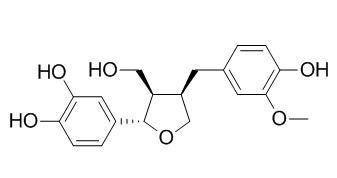Taxiresinol
Taxiresinol shows anticancer, antinociceptive, and antiallergic activities, it shows inhibitory activity on induced histamine release from the human basophilic cell line, KU812. Taxiresinol can protect the hepatocytes from apoptosis via an inhibition of TNF- alpha production by activated macrophages and a direct inhibition of apoptosis induced by TNF- alpha in D-GalN/LPS-treated mice.
Inquire / Order:
manager@chemfaces.com
Technical Inquiries:
service@chemfaces.com
Tel:
+86-27-84237783
Fax:
+86-27-84254680
Address:
1 Building, No. 83, CheCheng Rd., Wuhan Economic and Technological Development Zone, Wuhan, Hubei 430056, PRC
Providing storage is as stated on the product vial and the vial is kept tightly sealed, the product can be stored for up to
24 months(2-8C).
Wherever possible, you should prepare and use solutions on the same day. However, if you need to make up stock solutions in advance, we recommend that you store the solution as aliquots in tightly sealed vials at -20C. Generally, these will be useable for up to two weeks. Before use, and prior to opening the vial we recommend that you allow your product to equilibrate to room temperature for at least 1 hour.
Need more advice on solubility, usage and handling? Please email to: service@chemfaces.com
The packaging of the product may have turned upside down during transportation, resulting in the natural compounds adhering to the neck or cap of the vial. take the vial out of its packaging and gently shake to let the compounds fall to the bottom of the vial. for liquid products, centrifuge at 200-500 RPM to gather the liquid at the bottom of the vial. try to avoid loss or contamination during handling.
Molecules.2016, 21(6)
Int J Mol Sci.2020, 21(9):3392.
Microb Pathog.2024, 189:106609.
Food Science and Biotechnology2022, 10.1007.
Molecules.2022, 27(7):2093.
Int J Mol Sci.2023, 24(20):15320.
Int Immunopharmacol.2023, 123:110572.
ACS Omega2020, 5,33,20825-20830
J Ethnopharmacol.2017, 206:327-336
Korean J. Crop Sci.2018, 63(2):131-139
Related and Featured Products
Bioorg Med Chem. 2003 Nov 17;11(23):4945-8.
Absolute configuration and anticancer activity of taxiresinol and related lignans of Taxus wallichiana.[Pubmed:
14604656]
METHODS AND RESULTS:
Absolute configuration of Taxiresinol 1, a lignan from the heartwood of Taxus wallichiana has been determined as 8R, 8'R, and 7'R with the help of chemical correlation method and X-ray crystallography. The anticancer activity of Taxiresinol 1 and other two lignans 2, 3 were also studied.
CONCLUSIONS:
Taxiresinol 1 showed notable anticancer activity in the in vitro bioassays against colon, liver, ovarian and breast cancer cell lines.
Biol Pharm Bull. 2006 Nov;29(11):2310-2.
Antiallergic activity of aqueous extracts and constituents of Taxus yunnanensis.[Pubmed:
17077536]
The H2O, H2O/MeOH (1:1) extracts from the wood of Taxus yunnanensis showed a remarkable inhibitory effect on induced histamine release from the human basophilic cell line, KU812.
METHODS AND RESULTS:
The eleven constituents purified from the wood extracts of Taxus yunnanensis were tested by an in vitro histamine release inhibition assay. Among them, secoisolarciresinol and Taxiresinol were found to show inhibitory activities.
CONCLUSIONS:
A new neolignan, 2-[2-hydroxy-5-(3-hydroxypropyl)-3-methoxyphenyl]-1-(4-hydroxy-3-methoxyphenyl)propane-1,3-diol, was isolated from the wood of Taxus yunnanensis.
J Ethnopharmacol. 2003 Dec;89(2-3):265-70.
Anti-inflammatory and antinociceptive activity of taxoids and lignans from the heartwood of Taxus baccata L.[Pubmed:
14611890]
METHODS AND RESULTS:
Four taxoids (taxusin, baccatin VI, baccatin III and 1beta-hydroxybaccatin I) and five lignans (lariciresinol, Taxiresinol, 3'-demethylisolariciresinol-9'-hydroxyisopropylether, isolariciresinol and 3-demethylisolariciresinol) were isolated from the heartwood of Taxus baccata L. (Taxaceae) growing in Turkey through chromatographic techniques. In vivo anti-inflammatory and antinociceptive activity of these compounds were investigated.
CONCLUSIONS:
All the compounds were shown to possess significant antinociceptive activity against p-benzoquinone-induced abdominal contractions, while only lignan derivatives significantly inhibited carrageenan-induced hind paw edema in mice.
Planta Med. 2004 Jan;70(1):29-33.
Hepatoprotective effect of taxiresinol and (7'R)-7'-hydroxylariciresinol on D-galactosamine and lipopolysaccharide-induced liver injury in mice.[Pubmed:
14765289]
The hepatoprotective effect of Taxiresinol ( 1) and (7' R)-7'-hydroxylariciresinol ( 2), two tetrahydrofuran-type lignans isolated from the wood of Taxus yunnanensis, were investigated on D-galactosamine ( D-GalN)/lipopolysaccharide (LPS)-induced hepatic liver injury in mice.
METHODS AND RESULTS:
Pre-administration of Taxiresinol or 2 at doses of 50 and 10 mg/kg ( i. p.) at 12 and 1 h before D-GalN/LPS injection significantly inhibited hepatocyte DNA fragmentation and apoptotic body formation. Pre-treatment of these two lignans further suppressed hepatic necrosis which occur at later stage of D-GalN/LPS intoxication as demonstrated by the significant and dose-dependent reduction in serum glutamic pyruvic transaminase (sGPT) and serum glutamic oxaloacetic transaminase (sGOT) at 8 h after intoxication. The elevation of serum tumor necrosis factor-alpha (TNF- alpha) level by D-GalN/LPS toxication was significantly inhibited by Taxiresinol or 2 at doses of 50 and 10 mg/kg. Moreover, both of these lignans significantly protected hepatocytes from D-GalN/TNF- alpha-induced cell death in primary cultured mouse hepatocytes.
CONCLUSIONS:
These results suggested that Taxiresinol and 2 had protected the hepatocytes from apoptosis via an inhibition of TNF- alpha production by activated macrophages and a direct inhibition of apoptosis induced by TNF- alpha in D-GalN/LPS-treated mice.



